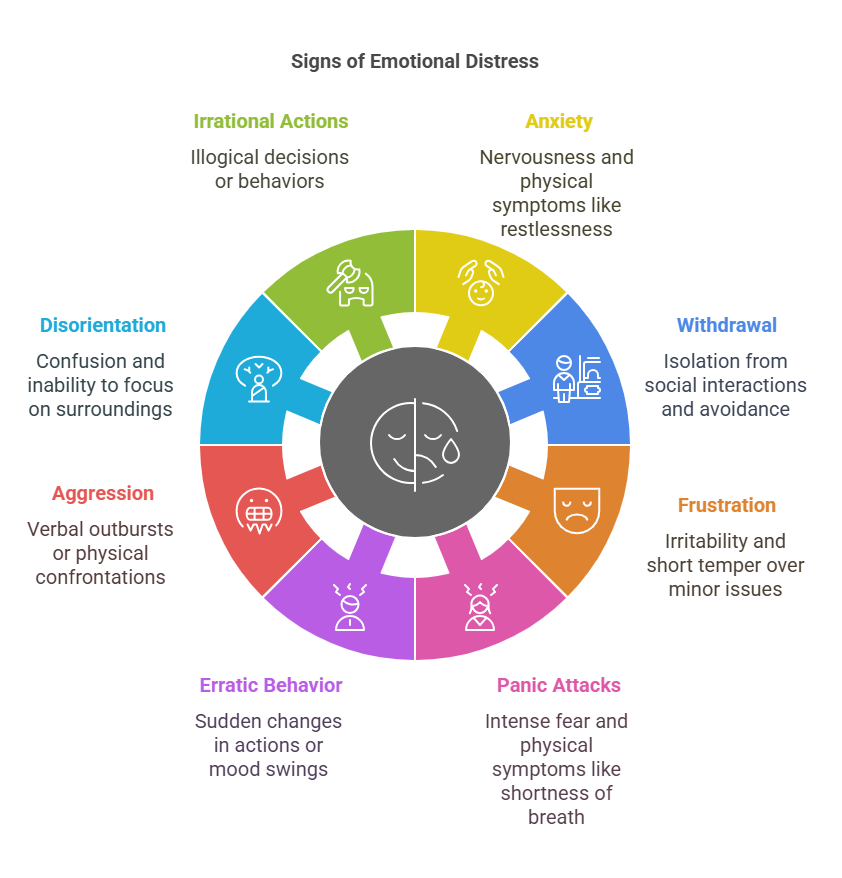Part 1 – Teach
12 Supporting Students in Distress
Identification and Response Strategies
Rowena Kidd
In a Nutshell
This chapter provides guidelines on how to identify signs of student distress, such as changes in behaviour or emotional response, and outlines steps you can take when you encounter a student in distress. These steps include listening respectfully, maintaining boundaries, and referring the student to appropriate support services. It is also important to seek support for yourself after dealing with a student in distress.
Why Does it Matter?
Mental and emotional wellbeing significantly impact a student’s ability to engage in their studies and learning. When in distress, students may exhibit behaviours that hinder their academic progress. It is crucial for staff to know how to support students during these times and how to refer them to specialist support services. By doing so, staff can help mitigate the negative effects of distress on students’ academic and personal lives.
What Does it Look Like in Practice?
In this section:
- How to recognise distress
- How to determine whether you should be concerned, and what to do if you are
How to Recognise Distress
Students experience a range of stressors including their studies, family environment, relationships, and other impactful events. All of these stressors can culminate to the point where a student may feel overloaded and unable to manage, leading to distress. This indicates that the student would benefit from support, including specialist intervention. Additionally, students may have neurodivergence, trauma, or psychological conditions that further impact their capacity to cope or manage expectations. Recognising that a student is in distress is crucial for providing timely and appropriate support. As academic educators or frontline staff, there are many ways you may become aware that a student is experiencing challenges. For example, a student may directly share their problems or concerns with you, both in relation to their studies and personal matters. You may also observe noticeable differences or changes in a student’s behaviour or be aware of an event or situation that is difficult or distressing for the student (e.g., the loss of a loved one, an accident, etc). Students may present in distress in various ways. Signs of distress may include anxiety, withdrawal, frustration, panic attacks, disorientation, aggression, intermittent or persistent crying, erratic behaviour, being irrational or difficult to reason with. Students may also display changes in usual behaviour, such as a formerly friendly and outgoing student becomes withdrawn. All of these are non-verbal indications that a student may be struggling. Recognising these signs is the first step in providing the necessary support.

How to Determine Whether You Should Be Concerned, and What to Do If You Are
It’s important to recognise that you don’t have to be concerned about every single student’s struggle. Students may have emotional responses to experiences within their academic journey. For example, it is natural for a student to become upset or display emotion in response to disappointment caused by failing an assessment task or exam, or not achieving as well as they might have anticipated. Students may seek your support, which can range from a simple expression of understanding and acknowledgement of the student’s situation to a more assertive referral to support services. However, if a student’s emotional state appears out of control or disproportionate to the situation, this may indicate that there are numerous other stressors impacting their ability to cope, and support services may be required. When presented with a student in distress, the most important thing is to remain calm. Before you respond, you may want to ground yourself by pausing and taking a deep breath. Your response may involve taking the following steps:
Step 1 – Remove the Student from Public/Semi-Public Areas
If it is safe for you, the student, and other members of the University community, take the student to a more private space such as an office or an area outside of the tutorial/lecture room. Offer them a glass of water or tissues if you are able. Give the student some time and space to manage their emotional response and collect their thoughts. If the student becomes distressed in an online forum, create a breakout room and ask the student to connect via the breakout room prompt; let them know that someone will join them to discuss their concerns. Alternatively, disconnect the student from the session and contact them via telephone or a private online session to follow up on the concerns.
Step 2 – Listen Respectfully to the Student’s Concerns
Listen, nod, paraphrase back to the student what they’re saying, and check your understanding of their concerns. In the “Further Resources” section of this chapter, there are useful materials to help hone your active listening and responding skills.
Step 3 – Be Consistent and Maintain Professional Boundaries
Do not attempt to “fix” the situation in the moment, even if this is within the scope of your role. When in a state of distress, people are unable to think clearly. It is unadvisable to encourage decision-making while the student is distressed. Clearly explain to the student that you are concerned for their wellbeing and encourage them to seek help.
Step 4 – Assess Their Level of Distress and Determine the Next Level of Response
- Low Distress:The student calms after a few minutes. It is advisable to check in with the student by asking how they are now, acknowledging their response, and providing information about and/or offering to help them engage with specialised services if they are agreeable.
- Medium Distress:The student’s distress does not settle while you are with them, and they exhibit behaviours such as crying or sobbing intermittently, appearing restless or agitated, showing an inability to sit still, erratic behaviour, inability to communicate, hostility or aggressive behaviour, language indicating a sense of hopelessness, unusual emotional responses, or making general references to suicide (e.g., “There’s no point continuing”). Refer them to appropriate specialist services either within your learning institution or community services.
- High Distress: This is when a student presents to you as help-seeking with immediate concerns for their safety or that of others. Examples include engaging in dangerous or risky behaviours, becoming violent or threatening, disclosing self-harm, or indicating an immediate intent to suicide. These situations require a more assertive intervention and specific assessment. Depending on the severity of the immediate threat, it may be appropriate to engage emergency services.
Follow your institution’s policy or procedures for Students at Risk. If your institution does not have a relevant policy, find out if there are any guidelines or recommendations issued by other bodies, such as national health services or mental health organisations. If you are involved in dealing with a student in medium or high distress, you should also seek support for yourself. After the incident, you should debrief with your Line Manager or a senior staff member if suitable, and consider accessing your institution’s Employee Assistance Program or other mental health support services available to you.
At UniSA…
At UniSA, there are several services, policies, and procedures available to support students in distress.
Low Levels of Distress
For students displaying low levels of distress, encourage them to book an appointment with the Counselling Service, whether the student is studying on campus or via UniSA Online.
Medium Levels of Distress
For students within the medium distress category, advise them that you are concerned for their wellbeing and encourage them to engage with the Counselling Service. You may then make an eReferral or email your concerns to counsellors@unisa.edu.au.
High Levels of Distress
For students in high distress, if there is an imminent risk to the student or anyone else’s safety, contact Campus Security (x88888 from internal phones, 1800 500 911, or a red wall phone if one is nearby). If the student is not on campus, please phone the Triage Counsellor at 8302 1055 (staff-only number) during business hours and email counsellors@unisa.edu.au. Students can also access after-hours crisis support by contacting the UniSA Out of Hours Crisis Line on 1300 107 441 or text 0488 884 163.
Additional UniSA Resources
Other UniSA resources that can help you respond to a student’s mental health crisis include:
- The Student Critical Incident Policy, which discusses principles for managing critical incidents involving UniSA students
- The Student Critical Incident Procedure, which lists actions to be taken when managing a critical incident
- The UniSA Staff Toolkit – Responding to students at risk is an on-line self-access module that provides training and access to resources on:
- How to respond to students who are distressed
- How to respond to abusive, threatening or aggressive behaviours
- UniSA staff to consult and services to refer students
- UniSA policies, procedures and codes
- The Dealing with Challenging Student Behaviour – Staff Toolkit webpage, which lists all of the above resources, as well as crisis and emergency contacts external to UniSA
- Students in Distress flowchart, which can help guide you through appropriate actions during a crisis
Knowledge Check – What Did You Learn?
To reinforce your understanding of how to identify and respond to student distress, please answer the following questions:
What Does It All Mean for Me?
Reflecting on this chapter, consider how you can apply these strategies and guidelines to your interactions with students. Here is an activity to help you integrate these concepts into your practice:
Activity: Develop a Response Plan for Student Distress
Use the H5P Documentation tool below to create your response plan and download your text and ideas via the Text Export page. This exercise will help you systematically apply the principles of identifying and responding to student distress, ensuring you are equipped to support your students’ mental and emotional wellbeing.
Further Resources
- Protocols for assisting distressed students: Essentials (Staff course) OER by RMIT Mental Wellbeing Initiative https://rmit.pressbooks.pub/assistingdistressedstudents/
- The Fine Art of Active Listening (2016, author unknown?) AIPC Article Library: https://www.aipc.net.au/articles/the-fine-art-of-active-listening/
- What to say when someone is struggling, from Samaritans.org: https://www.samaritans.org/how-we-can-help/if-youre-worried-about-someone-else/how-support-someone-youre-worried-about/what-do-if-you-think-someone-struggling/
- How to start a conversation and examples (videos) of actual conversations, from Scottish Action for Mental Health: https://www.conversationsinthecommunity.org.uk/modules/3/index.html#/id/co-03_01
- Helping Someone Else by Black Dog Institute – https://www.blackdoginstitute.org.au/emergency-help/helping-someone-else/
Media Attributions
- Signs of Distress © Generated using Napkin.ai is licensed under a All Rights Reserved license

